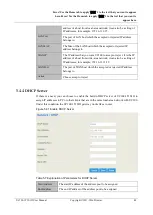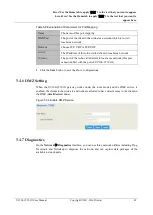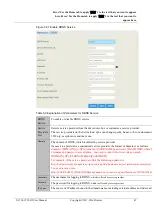
Error! Use the Home tab to apply
标题
1 to the text that you want to appear
here.Error! Use the Home tab to apply
标题
1 to the text that you want to
appear here.
UC100-1T1S1O User Manual
Copyright©2011-2016 Dinstar
52
Table 5-13 Explanation of Parameters for SIP Profile
Name
The name of the SIP profile
Local Listening Interface
The
local listening interface of this SIP profile. It can be WAN
port, LAN port, Open VPN, L2TP and PPTP.
If the SIP profile is used by a SIP trunk, the interface filled in
here is the listening port for the SIP trunk.
Local Listening Port
The local listening port of this SIP profile. If the SIP profile is
used by a SIP trunk, the port filled in here is the listening port
for the SIP trunk.
DTMF Type
DTMF is short for Dual Tone Multi Frequency
There are three DTMF modes, including SIP Info, INBAND,
RFC2833
RFC2833-PT
RFC2833
payload coding
PRACK
Provisional Response ACKnowledgement
Session Timeout
The validity period of a SIP session. When a SIP session times
out, an invite message needs to be sent to refresh the session,
otherwise, the session ends;
It is 1800 seconds by default
Inbound Codec
Negotiation Priority
To take the remote device or the local device as priority for
inbound codec negotiation
Assume local device supports PCMA, PCMU, G.729 and
G.723, while the remote device supports G.723 and G.729
If remote device is taken as codec negotiation priority, G.723
will be the codec mode, since the remote device supports
G.723 and G.729 and G.723 is prior to G.729
Inbound Codec Profile
The codec supported by SIP for inbound calls
Outbound Codec Profile
The codec supported by SIP for outbound calls
Detect Extension is
Online
Whether to detect the SIP extension using this SIP profile is
online or not
Allow Unknown Call
If this function is enabled, incoming calls from unknown
sources are allowed. Unknown sources are those IP addresses
that do not fall into the source range configured for SIP trunks
or SIP extensions















































